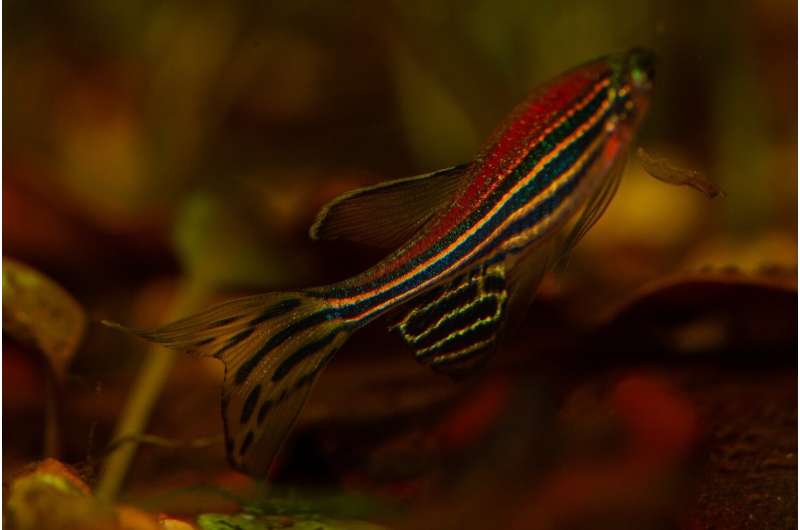University of Cincinnati student uses zebrafish to study spinal deformities

Popular in aquariums all over the world, the zebrafish is native to South Asia. But here in a Cincinnati Children's laboratory, the freshwater variant plays a vital role in scientific discovery.
The iconic stripes are eye-catching but it's the transparency of zebrafish embryonic tissue which are most prized by researchers like Oriana Zinani, a fifth-year doctoral student in molecular developmental biology in the University of Cincinnati College of Medicine. The patterning of the zebrafish's spine gives the appearance of stripes; it is controlled by segmentation genes which function like a clock.
Zinani is part of a team of scientists in the laboratory of Ertuğrul Özbudak, Ph.D., associate professor of pediatrics at UC and Cincinnati Children's Hospital Medical Center. The team is studying a gene mutation that causes congenital scoliosis, a birth defect characterized by failure of separation of vertebrae and disordered rib cages. Zebrafish eggs are fertilized and develop outside of the mother's body making visualization with high resolution imaging easier for researchers. Zebrafish and humans share 70% of the same genes.
"We can see exactly what's happening while it's happening in zebrafish providing us with insight for human embryonic development," says Zinani. "My research asks the question, 'How does the zebrafish embryo robustly achieve precise development in a variety of environments that consider variables such as temperature fluctuations and exposure to different oxygenation levels?' We realized that embryos need to develop mechanisms to filter out the noise for development, and I focus on what those mechanisms involve."
Scientists for some time have known that specific genes pair up on the same chromosome and appear together or "co-express" in cells and tissues. In humans, at least 10% of genes pair on the same chromosome. Why this occurs has been unknown but the team—including Zinani, Özbudak, Kemal Keseroğlu, a research fellow at Cincinnati Children's, and Ahmet Ay of Colgate University—did an experiment separating two genes that were paired together to determine the role they may play in spinal column development.
The team's findings were recently published in the scholarly journal Nature.
Using the gene-editing tool CRISPR-Cas9, the research team performed a simple experiment using a zebrafish model and separated two genes that pair up to control the healthy development of the spine. The separated genes have broken their co-expression. Instead of the precise segment boundaries we are used to seeing in zebrafish embryos, we see instead a fused tissue, which ultimately leads to failed vertebrae formation.
"With two paired functional genes we see normal healthy development," says Zinani. "If this were a human the person would have no disease. If we take the normal gene pairs and separate them, without creating any mutation at all, we see disease development under environmental stress."
Images of a zebrafish with the separated genes show a jagged vertebrae that's cracked, broken and fused, explains Zinani. The zebrafish has a diseased phenotype leading to congenital scoliosis. Researchers also raised the zebrafish with separated gene pairs in different temperatures to better understand the impact of environmental pressure on development. Paired genes lead to beneficial spinal development, particularly under environmental stress. Separation of the genes are more likely to lead to deformities of the spine and congenital scoliosis in zebrafish.
"What is also exciting is many genes responsible for the development of diabetes, cancer and autoimmune disorders also present in gene pairs in human genome" says Zinani. "We believe more research will show the importance of those genes maintaining close proximity to their partners. If the process of having genes next to each other influences healthy development and adult life, we have a new target to consider in studying disease formation."
Özbudak said Zinani's work will be useful in future research.
"What Oriana discovered during her graduate study could shed light on why organisms maintain particular gene orders in their genome: to coordinate expression of genes functioning in same biological processes," he said.
More information: Oriana Q. H. Zinani et al. Pairing of segmentation clock genes drives robust pattern formation, Nature (2020). DOI: 10.1038/s41586-020-03055-0


















